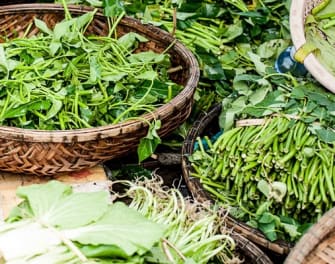What would pesto be without basil, or salsa without cilantro? Whether used by the pinch or by the bunch; fresh herbs pull a recipe together by infusing the dish with unparalleled aromas and flavors. Sometimes, when the effect you seek is subtle, refined, and delicate, a hint of herbs is enough; other times, handfuls are required.

Basil
Basil is one of the most common culinary herbs. Sweet basil, (the most common type), is used throughout the world both as a fresh herb or dried
- Use in tomato and pasta dishes
- Crumble over baked chicken, lamb, or fish
- Works well with garlic, thyme, oregano, and parsley
- Use in sandwiches and salads
Chives
Toss chives into a dish at the last minute as heat destroys their delicate onion flavor. Thinly slice them to maximize their taste, or use finely snipped chives as a garnish.
- Delicate onion-like flavor for fish dishes
- Great for dips, quesadillas, and on potato dishes
Cilantro
Some call it cilantro; others call it coriander, but whatever you call it, chances are you either love it or hate it. Cilantro has a pungent flavor and its leaves are often mistaken for flat-leaf parsley so read the tag before you buy.
- Use in Mexican and Southwest dishes
- Adds distinctive flavor to salsas, soups, stews, salads, vegetables, fish, and chicken dishes
- Add at the last moment as high heat lessons the flavor
Dill
Since ancient Roman times, dill has been a symbol of vitality. In the kitchen; its feathery leaves lend a fresh, sharp flavor to all kinds of foods.
- Adds a delicate flavor to fish, shell fish, vegetables, and dips
- Sprinkle over casseroles before baking
- Use in fresh salads and potato dishes
- What would the ‘Dill Pickle’ be without the Dill?
Lemon Grass
A necessary ingredient in Asian cuisine
- Add flavor to fish, poultry, and stir fry dishes
- Also acts as a mosquito deterrent
Lemon Verbena
A culinary herb with a wonderful, strong, lemon scent
- Use in all forms of baking from cookies to cakes
- Excellent for herb teas
Mint
Mint isn’t just a little sprig that garnishes your dessert plate. It is extremely versatile and can be used in both sweet and savory dishes.
- Use in salads and zesty marinades
- Adds flavor to teas (both iced and hot)
- Great as a dessert topping
- Add a fresh accent to mixed cocktails (The Mojito wouldn’t be a Mojito without the mint)
Oregano
Oregano grows wild in the mountains of Italy and Greece; it’s Greek name means “Joy of the Mountain”.
- Works well with lamb, pork, and beef dishes
- Use w/ garlic and oil over fish and poultry
- Accent pasta sauces, salad dressings, and ground meat dishes
Parsley
No refrigerator should be without parsley. It’s simply the workhorse of the herb world and can go with just about any dish you cook. It’s mild, grassy flavor allows the flavor of other ingredients to come through. Flat leaf varieties are great for cooking while it’s curly brother is most often used as a garnish.
- Use generously for green and pesto sauces
- Combine w/ melted butter for a simple vegetable or pasta topping
- Add directly to cooked foods and salad dressings
- Sprinkle a mixture of chopped parsley and garlic on roasted lamb, steaks, fish, and chicken
Rosemary
In Latin, rosemary means ‘Dew of the Sea’. Rosemary is one of the most aromatic and pungent of all herbs. Its needle-like leaves have a pronounced lemon-pine flavor.
- Pairs well with lamb, steaks, and poultry dishes
- Mix w/ garlic to season meat stews and marinades
- Use in lighter fish dishes, tomato sauces, and with vegetables
- Great addition to steamed vegetables, potatoes, and stir fry dishes
- Use sparingly as Rosemary is very pungent and can be over-powering
Sage
Sage is native to the northern Mediterranean coast, where it is frequently used in cooking. Sage’s long, narrow leaves have a distinctive fuzzy texture and a flavor reminiscent of eucalyptus, cedar, lemon, and mint.
- Enhances seafood, vegetables, and breads
- Mix w/ butter and top grilled steaks, chicken, and pork
- Use in marinades for pork, beef, and turkey dishes
Tarragon
Native to Siberia and western Asia, tarragon is primarily used in French cooking. It is often added to white wine vinegar; lending a sweet, delicate licorice-like perfume and flavor.
- Add flavor to egg and cheese dishes, fresh fruit, and light soups
- Use w/ melted butter and lemon to baste chicken or seafood
Thyme
Thyme comes in dozens of varieties; however most cooks use French Thyme. Thyme is one of the most important herbs in European cooking. It has a subtle, dry aroma and a slightly minty flavor.
- Rub on lamb, pork, and beef roasts
- Add to cheese, tomato, and egg dishes
- Blend into poultry stuffing, tomato sauces, and chili
